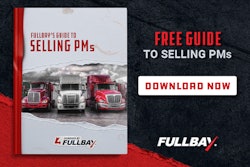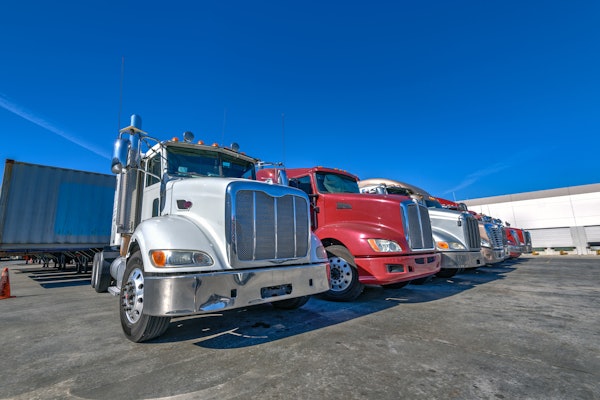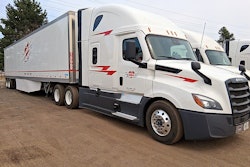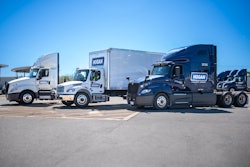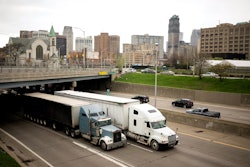Payload, low maintenance and fuel efficiency are critical to financial success. Today’s van trailers contribute to the cause.
With the high cost of fuel and fierce competition among fleets, “You’ve got to haul more freight per vehicle,” says Craig Bennett, president of Utility Trailer. And lighter trailer dry weight clearly is one way to do that. That’s the main reason Utility is offering a wide axle/suspension system designed to accommodate wide-based single tires without requiring bearing-damaging wheel offset.
Not only do four wide-based singles weigh less than the eight tire/wheel assemblies on a conventional trailer tandem, they also are claimed to be more fuel-efficient since they have fewer sidewalls flexing and consuming energy. A plus, says Bennett, is that they also improve handling and roll stability.
And there are other advancements in today’s trailer technology: State-of-the-art engineering has made them not just lighter but stronger.
“What has changed to improve structural integrity is a more accurate method in determining where stress loads are the highest,” says Mark Roush, director of engineering for Vanguard National. “This has been accomplished primarily with better design tools that can analyze the properties of the various materials used in the construction process.” By replacing heavier components with equally strong, lighter-weight materials and adding extra strength in areas that need beefing up, trailer designers have been able to build significantly better trailers to carry specific loads without fatiguing elements of the design, Roush says.
“We’ve continued to reduce trailer weight by utilizing lighter, higher-strength materials in practically every area of the trailer,” says Rod Ehrlich, chief technology officer for Wabash National. “The use of composite floors is another way to reduce trailer weight and increase floor load capacity.”
But how much weight can be taken out before durability is affected? “We’ve seen some trailer-suspension component cracking,” says Darry Stuart, president of DWS Fleet Management, based in Wrentham, Mass. “Too much weight has been taken out of some areas, and in those cases, we have light weight and durability boxing with each other.”
Another trend in van trailers is composite panels used as side, front and rear door materials. These have gained popularity in freight vans, providing maximum interior width and length, and a smooth snag-free interior, says Roush. For long-haul truckload operations, composite-plate trailers are now the standard, he says.
According to Charles Cole, Utility’s manager of technical sales and product training, 4000 D-X thin-wall dry vans have a 101-inch-wide interior, and logistic posts at least every 24 inches for more cargo-shoring versatility.
“Thin-wall trailer designs continue to gain popularity because they provide fleets with added interior width and cube capacity,” says Ehrlich. “As you would expect, more interior width allows for more freight per trailer and better margins for fleets.” Wabash’s DuraPlate trailer allows fleets to “pinwheel” pallets and increase cargo capacity, Ehrlich says.
The DuraPlate HD also utilizes a unique heavy-duty base plate designed to eliminate the need for an interior scuff liner, which Ehrlich says it a high-maintenance item. “It also provides 22 inches of lower sidewall protection, where it’s estimated that 90 percent of trailer damage occurs,” he says.
Chris Hammond, vice president of dealer sales for Great Dane, agrees that durability and maintenance have become major issues for fleets. “Trailer companies have either moved away from, or engineered, alternatives to traditional plywood liners,” Hammond says. One such alternative is Great Dane’s PunctureGuard, a thermoplastic liner and scuff material designed to increase strength and puncture resistance without adding weight.
Newer materials such as composite panels are better all around, according to John Sullivan, vice president of maintenance and purchasing for Performance Transportation Services, based in Wayne, Mich. “They enlarge the ‘freight envelope,’ they’re tougher and they cost less to repair,” says Sullivan, who’s also is a fan of spec’ing anti-snag roof bows because they “prevent damage to cargo as it’s being loaded.”
Corrosion not welcome
Savvy trailer purchasers are willing to spend more for the protection of certain areas of the trailer that are damaged prematurely by harsh road chemicals or repeated exposure to the elements, says Vanguard’s Roush. Protection options include hot-dipped galvanized rear frames, impact guards and other rear components that come in contact with docks that scrape away paint, causing rust; hot-dipped galvanized understructures, landing gear bracing and front components that are impacted during coupling and uncoupling; and coating crossmembers with materials such as wax that is self-healing following impact with road debris.
Utility has added a stainless-steel door frame and buckplate on its thin-wall dry vans, integrated the rear threshold to help eliminate rotting wood beneath, and provided corrosion protection with the use of paraffin-based soft coatings and paints.
Another weapon in the war against corrosion is Great Dane’s CorroGuard, a spray-in-place, thermoplastic elastomer coating. Applied to suspensions and support gear, CorroGuard reportedly protects against road abrasion and corrosion, and resists deicing chemicals, road debris, climate fluctuations, ice and snow. It’s airtight and watertight, and according to the company, it won’t crack, warp or flake.
No doubt, trailer manufacturers are taking more precautions against corrosion, but the war is far from over. “Corrosion is still getting worse,” says DWS’ Stuart. “We’re seeing better coatings, and just driving on the highway, you can see a lot more stainless and galvanized steel. But the use of newer, corrosive ice-melting chemicals is spreading faster than the industry can keep up.”
Corrosion continues to be a major topic at meetings of the Technology and Maintenance Council, and hopefully “we’ll find the answer,” says Stuart.
Where it all meets the ground
In addition to trailer structures being stronger, lighter and more resistant to corrosion, running gear and ancillary items also have improved in recent years, trailer manufacturers agree. From a manufacturer’s viewpoint, that’s because they come all buttoned-up as a module.
Performance Transportation’s Sullivan likes the modular approach. “If you get the whole package – axles, suspensions, brakes, wheel ends, etc. – from one supplier, you’ll get a better price and a better warranty,” Sullivan says.
As relatively recent improvements, Utility’s Cole cites better wheel seals and bearings, lighter wheel-end components, better wiring harnesses and LED lighting, which lasts indefinitely and is becoming more affordable. Also, onboard tire inflation systems are a safety feature.
“Keeping tires properly inflated is the single most critical factor for getting the most out of tires,” says Great Dane’s Hammond. “By maintaining the proper inflation pressure, tires last longer and are safer.”
No argument from Sullivan, who specs onboard tire inflation systems and notes that, “They’re good for fuel economy and tire wear – we’ve seen a payback in less than six months.”
In sum, it would be fair to say that today’s trailers, if properly spec’d, are more productive, require less maintenance, are safer and can last longer. But know what you’re buying, advises DWS’ Stuart. “Visit the factory, do a ‘paper’ pilot inspection and make sure you’re getting what will do the job,” Stuart says. “And make sure you have a good, solid trailer and tire maintenance program. Otherwise, all the gadgets in the world won’t do you any good.”



